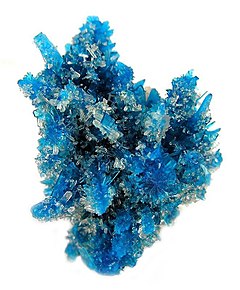Pentagonite
Appearance
| Pentagonite | |
|---|---|
 | |
| General | |
| Category | Silicate mineral |
| Formula (repeating unit) | Ca(VO)Si4O10·4(H2O) |
| IMA symbol | Ptg[1] |
| Strunz classification | 9.EA.55 |
| Crystal system | Orthorhombic |
| Crystal class | Pyramidal (mm2) (same H-M symbol) |
| Space group | Ccm21 |
| Unit cell | a = 10.386(4) Å, b = 14.046(7) Å, c = 8.975(2) Å; Z = 4 |
| Identification | |
| Color | Greenish blue |
| Crystal habit | Prismatic crystals, often as radiating clusters |
| Twinning | Multiple twins producing a pseudo pentagonal symmetry |
| Cleavage | Good on {010} |
| Tenacity | Brittle |
| Mohs scale hardness | 3 - 4 |
| Luster | Vitreous |
| Diaphaneity | Transparent |
| Specific gravity | 2.33 |
| Optical properties | Biaxial (-) |
| Refractive index | nα = 1.533 nβ = 1.544 nγ = 1.547 |
| Birefringence | δ = 0.014 |
| Pleochroism | Visible: X=Z= colorless Y= blue |
| 2V angle | Measured: 50° |
| References | [2][3][4] |
Pentagonite is a rare silicate mineral with formula Ca(VO)Si4O10·4(H2O). It was named for the unusual twinning called a fiveling with an apparent five-fold symmetry.[2] It is a dimorph of cavansite.
Pentagonite was first described in 1973 for an occurrence in Lake Owyhee State Park, Malheur County, Oregon.[3] It has also been reported from the Pune district of India. It occurs as fracture and cavity fillings in tuff and basalt. It occurs with cavansite, heulandite, stilbite, analcime, apophyllite and calcite.[2]
References
[edit]- ^ Warr, L.N. (2021). "IMA–CNMNC approved mineral symbols". Mineralogical Magazine. 85 (3): 291–320. Bibcode:2021MinM...85..291W. doi:10.1180/mgm.2021.43. S2CID 235729616.
- ^ a b c Handbook of Mineralogy
- ^ a b Mindat.org
- ^ Webmin
Wikimedia Commons has media related to Pentagonite.
